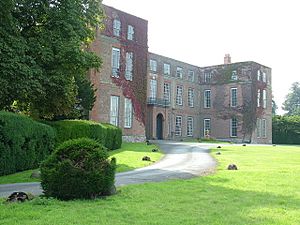Thomas Glemham facts for kids
Sir Thomas Glemham (born around 1594 – died 1649) was an English soldier and landowner. He was also a politician, serving in the English Parliament between 1621 and 1625. During the English Civil War, he was a key commander in the Royalist army, fighting for King Charles I.
Contents
Early Life and First Steps in Politics
Glemham was the son of Sir Henry Glemham from Glemham Hall in Little Glemham, Suffolk. After studying at Trinity College, Oxford, he decided to become a soldier. He served in armies across Europe from 1610 to 1617, gaining valuable experience. He was made a knight on September 10, 1617.
In 1621, he was elected as a Member of Parliament (MP) for Reigate. When his father passed away in 1632, Thomas inherited the family estate at Little Glemham.
He was elected as an MP again for Aldeburgh in 1625 and 1626. After this, he joined an important military trip as a Captain with the Duke of Buckingham to La Rochelle in France. He was captured by the French but was later set free. He then worked as a Justice of the Peace, helping to keep law and order.
In 1639, when the Second Bishops' War began, Glemham was made a lieutenant-colonel. After a defeat for the English at the Battle of Newburn, he became the Governor of Hull for several months before returning to London in 1641.
Fighting in the First Civil War
In early 1642, Sir Thomas Glemham was with King Charles I in York. He tried to enter Hull with a group of important people to get back weapons stored there. However, the Governor, Sir John Hotham, who supported Parliament, stopped them. The King demanded to enter the city but was refused. He declared Hotham a traitor, and Glemham's group had to leave.
Glemham stayed in northern England after the King moved south. He took part in the unsuccessful Siege of Hull (1642). In October 1642, he was made Governor of York. He stayed there until November 1643, when he took charge in Northumberland to prepare for a possible invasion by Scottish Covenanters. The Scots did invade in January 1644 with a very large army. Glemham had to quickly retreat to Newcastle upon Tyne and join the main Royalist army led by the Marquess of Newcastle.
The Marquess of Newcastle's army also had to retreat to York when Parliamentarian armies threatened that city. When they arrived on April 19, Glemham became Governor of York again. During the Siege of York, the Royalist soldiers defended the city bravely. Glemham was praised for destroying a Parliamentarian mine by digging a counter-mine that flooded the attackers' tunnel. On July 1, a Royalist army led by Prince Rupert of the Rhine arrived and helped the city. However, the next day, Rupert and Newcastle's forces were badly defeated at the Battle of Marston Moor. Newcastle went to live in Hamburg, and Rupert left with the remaining soldiers. Glemham was left with only 1,500 men to defend York. Despite this, he held out until July 16 and managed to get good surrender terms. No Scottish troops were allowed into the city, and the soldiers who wanted to keep fighting were allowed to leave with their weapons and were given safe passage to Skipton. From there, some men went south to join the King's main army, while Glemham and about 200 officers went to Carlisle.
Glemham was then made Commander-in-Chief of the four northernmost counties of England, but he mostly controlled only Carlisle itself. From October 1644 to June 1645, Carlisle was surrounded by Scottish forces led by Major General Sir David Leslie. Glemham again defended the city actively, often raiding the Scottish lines. He finally surrendered when all supplies ran out, and the soldiers and townspeople faced starvation. Leslie again gave good terms, allowing the soldiers to leave with their weapons and escorting them to Hereford to join the King.
Glemham received a special degree from Oxford University on April 22, 1645. In October 1645, he was appointed Governor of Oxford, which was the King's capital during the war. He made many preparations to withstand a long siege, even though the King had very few soldiers left. In April 1646, the Parliamentarian Commander-in-Chief, Sir Thomas Fairfax, began the final Siege of Oxford. The King secretly left Oxford. Glemham continued to defend the city, even though some of the King's advisors trapped in Oxford wanted to surrender. While talks for surrender and heavy bombing of the siege lines were happening, a letter arrived from King Charles, who was now a prisoner of the Scots. The King ordered Glemham to stop fighting. The 3,000 soldiers marched out with their weapons and then disbanded. After paying a fine to keep his estates, Glemham went to live in another country.
The Second Civil War and Final Years
In early 1648, Glemham joined other important Royalists in Edinburgh. In April, they crossed into England and started a Royalist uprising. Glemham once again took command at Carlisle. However, the Scottish army that invaded England to support them was defeated at the Battle of Preston, and the Royalist groups in the north were soon stopped.
Glemham went into exile again in 1648 and passed away in Holland in 1649.
Family Life
Sir Thomas Glemham was married twice. His first marriage was in 1619 to Catherine, the daughter of a London merchant named Sir Peter Vanlore. They had three sons and three daughters. His second marriage was in 1630 to Mary, the daughter of Thomas Perient. Through his first marriage, he gained ownership of the manor of Burwell in Lincolnshire.


